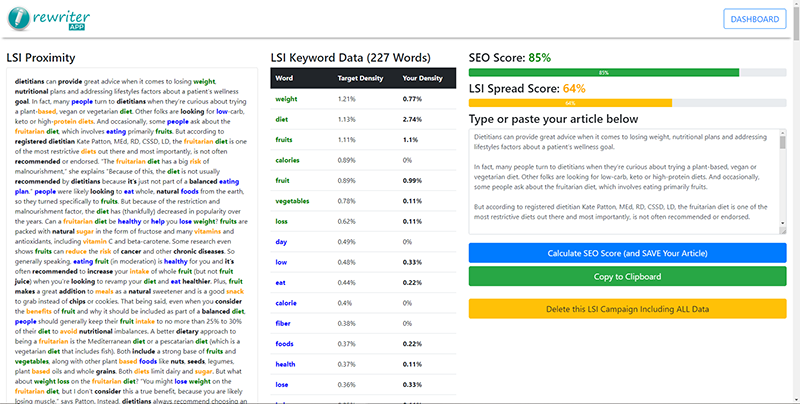If you have followed me for a reasonable amount of time, or bought any of my products, you’ll be well aware that I’m an advocate of ‘Latent Semantic Indexing’ (aka L.S.I.) when it comes to SEO and ranking content.
Or, what I prefer to call it… Semantic Optimization.
The phrase ‘Content is King’ has been banded around for a long time now, and with good reason. When it comes to SEO practices – ‘content’ and ‘semantic optimization’ go together like ‘peas and carrots’.
Whether it’s an article, post title, H tags, alt tags, or even anchor text in backlinks – They can all be semantically optimized to help increase the Google ranking of the page (or post).
So, What is Semantic Optimization?
Ok, first I’m going to give you a definition that was published by SearchEngineJournal.com, and it goes like this…
Latent semantic indexing (also referred to as Latent Semantic Analysis) is a method of analyzing a set of documents in order to discover statistical co-occurrences of words that appear together which then give insights into the topics of those words and documents
However, there is an easier way to explain this using a simple ‘practical’ concept.
Want to play a little game?
So, let’s pretend for a minute that YOU’RE Google, and you’re crawling (reading) a blog post to determine what it is about.
Imagine that after crawling this blog post you have identified the following words…
- fluffy
- cute
- playful
- claws
- saucer
- milk
- kindle
Just by reading that short list of words, what do you think that blog post might be about? What comes to mind?
Take a guess!
I’d imagine most people would guess something like ‘Kittens’, right? Is that what you guessed?
That’s exactly what Google does every time it finds and crawls a new web page or blog post.
It crawls the content and analyzes all the wording on the page (and in the headings and tags) to try and determine what the page is about.
You can’t just include your target keyword within your content and expect Google to agree with you that your content is ABOUT YOUR KEYWORD.
You have to really delve into the topic of your keyword and dig deep, and make sure you answer the users search query and provide real value.
Let’s look at another short list of words, and see if you can guess what the topic is about.
I won’t even include the ‘obvious’ word in this list!
- foundation
- lay
- laid
- mortar
- feather
- level
- chisel
- straight
- gaps
- mixture
Can you guess what this one is? The topic is ‘brick laying’. (The obvious word I left out the list was of course ‘brick’)
Here’s something that you need to think about when you create a blog post or piece of content around a specific keyword. Every keyword has a set of semantic words (LSI words) that are highly relevant and relational to it.
With this in mind, when you include your target keyword (that you’d like to rank for) in your post title and in your ‘article’, it doesn’t mean you will rank for it in the search results.
Google analyzes ALL the words used within a webpage or blog post and then builds a semantic theme. It will then use that semantic theme to determine what keywords the page should appear for in its search results.
Google is clever!
So, What’s the Solution
The solution is to write a really good piece of content that answers the search query, and goes deep. Go into detail to answer the question.
It’s about writing for the reader. Writing for your audience.
AFTER doing that you can then go over your content and analyze the words you have used.
How I Power Up My Content to Rank Higher
If I write an article or piece of content I run it through the SEO feature of my RewriterApp software to strengthen the article up so it ranks higher in Google.
How it Works
My RewriterApp feature extracts all the top ranking webpages for your target keyword. These are the webpages that Google is already ranking at the top of their search results. It then extracts all of the LSI words from those pages and creates a ‘weighted’ data set so it knows which are the most important / relevant words in that set.
You can then paste your article / content into the software and it will then calculate an SEO Score based on that ‘data set’ and let you know how it can be improved.
You can add some more LSI words to your article, and increase the score.
Then simply publish your new ‘revised’ article for improved rankings and to get more traffic from Google.
How to Use Latent Semantic Indexing With YouTube
That’s right, you can apply this same SEO concept to your YouTube videos too. You do this by applying these same principles to the video title, description and tags.
This can have a tremendous impact on your rankings in YouTube, as it’ll allow you to rank for specific keywords in the YouTube ‘search results’.
If you’re interested in using the power of semantic optimization for your websites, content or videos then feel free to check out my TWO software apps below.
RewriterApp (Boost the Google Ranking of Your Web Pages and Blog Posts)
TubeSerp (Rank Your Videos Higher in YouTube for Specific Keywords)
I’d also love to hear your thoughts about this, so please do leave a comment below in the comments section.
Until next time
Andy Black
